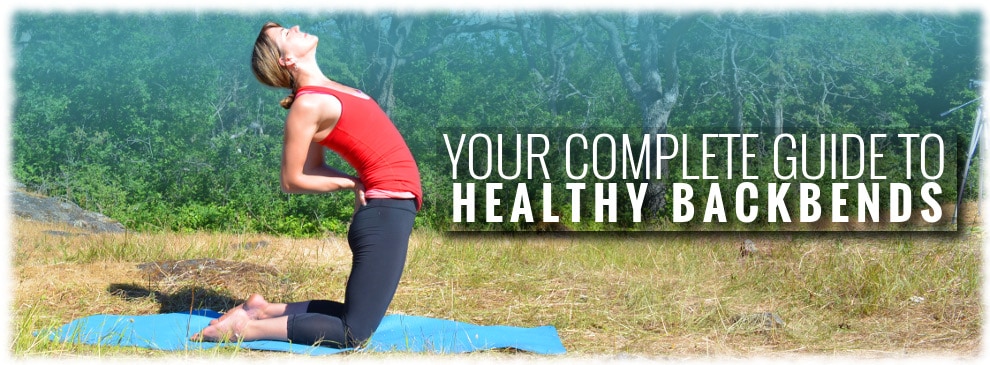How do you do a backbend safely while fully experiencing all of its benefits?
For many, backbend stretches are an essential aspect of a yoga practice. They can feel amazing, opening your spine and heart, releasing deeply-held tension and invigorating your mind and body. However, backbends can easily be done incorrectly, putting unnecessary stress on the spine, particularly the lower back, and potentially leading to chronic problems.
We’ve created this page to help you understand how to do a yoga backbend with grace, lightness and ease. Below, you will find information on the benefits and risks of backbends, along with classes and tutorials that will teach you how to move safely into a strong, well-aligned backbend.
The Benefits Of Backbends
Backbends bring many benefits. They:
- Wake you up, energizing and giving you a boost of energy, mental clarity and life force.
- Calm you down, stimulating your sympathetic nervous system, helping relieve stress, anxiety and insomnia.
- Stimulate the immune system by compressing your thymus gland, spleen and lymph nodes, stimulating the movement of lymphatic fluid.
- Move energy (prana), through your body, helping clear blocks and bringing vital energy to areas that need it most.
- Contribute to spinal health by helping to orient your spine in a healthy, tall, aligned position.
The Risks
Backbend poses can put a lot of pressure on the most vulnerable area of the spine, the lower back. Because of its lordosis (forward curvature) the lower back already easily accommodates a backbending motion, and without proper stabilization your back can develop a pivot point, pinching the discs between the vertebrae and potentially leading to more serious issues if repeated over time.
Learn To Do A Healthy Backbend
Learning how to support your spine begins with locating, engaging and strengthening the deeper core muscles. We refer to them in yoga as your bandhas, and the two that are most responsible for core stability are mula bandha and uddiyana bandha. They are associated, respectively, with the pelvic floor (perineal muscles or pubococcygeal muscles) and the transverse abdominis. Other muscles, such as the multifidus and diaphragm, are also involved in core strength. Before we move into the video instruction, let’s address a few of the common questions.
Do I tuck my tailbone? Do I press my belly in? Do I tilt my pelvis?
The quick answer to all of the above is ‘yes!’. You absolutely want the pelvis to move with the backbend (to tilt back), which essentially tucks your tailbone. Pressing your belly in activates the proper abdominal muscles, which also helps tilt the pelvis back.
However, while your pelvis needs to tilt so that your lower back doesn’t have to manage the backbend alone, your tailbone tuck shouldn’t be forceful. You aren’t wrenching your tailbone down with your glutes; your pelvic tilt happens when you activate your deep core muscles, which are designed to help support the lower back within a backbend. Learning to use your deep core muscles will help ensure that you’re moving your spine in a healthy way.
Ok, let’s learn how to do it!
Eight Steps to Understand Core Activation
Instructor: David Procyshyn
We have a simple series in our Yoga Anatomy section that teaches you how to feel, engage and strengthen your core muscles. Once you learn this, you can apply it to everything in your yoga practice and your life. Your back will feel less vulnerable, stronger and healthier. Here are the steps:
- Core Activation Part I: The Pelvic Floor | 4min
- Core Activation Part II: The Transverse Abdominis | 4min
- Core Activation Part III: The Multifidus | 3min
- Core Activation Part IV: Putting It All Together | 4min
- Core Activation Part V: The Fragile Egg | 3min
- Core Activation Part VI: Incorporating Movement | 3min
- Core Activation Part VII: Taking It Up A Notch! | 2min
- Core Activation Part VIII: Summary | 2min
Do A Backbend!
After you get proficient with what you have learned in the eight steps above, you can practice applying the principles to a backbend. First, I show you how to do a full-body backbend while standing. Then, in a 2-part video series, Rachel teaches you the principles of a healthy backbend while doing camel pose (ustrasana).
Hatha Yoga | 3min | Beginner
Instructor: David Procyshyn
Hatha Yoga | 3min | Beginner
Instructor: Rachel Scott
Hatha Yoga | 3min | Beginner
Instructor: Rachel Scott
Incorporate It Into Your Yoga Practice
Once you feel comfortable doing backbends on their own, you can begin to incorporate them into a full practice. Luckily, we have a great series of classes that help you build your strength and flexibility in a gradual, healthy way.
Hatha Yoga | 9 min | Beginner
Instructor: David Procyshyn
Props: None
Hatha Yoga | 38 min | Challenging Beginner
Instructor: Anastasia Hangemanole
Props: Block
Vinyasa Yoga | 39 min | Intermediate
Instructor: Fiji McAlpine
Props: None
Vinyasa Yoga | 59 min | Advanced
Instructor: Crista Shillington
Props: Strap
Do A Peak Pose Challenge!
We also have several series of classes which we call our Peak Pose Challenges. Each of these series guides you progressively towards one challenging pose, providing you with the strength, flexibility and focus you will need to get there. Below are the challenges that are devoted to yoga backbending poses.
Classes: 4
Difficulty: Intermediate
Props: None
Classes: 4
Difficulty: Intermediate
Props: Strap
Classes: 2
Difficulty: Challenging Intermediate
Props: None
Happy back bending! Let us know if this page helped you out by commenting below!



Comments
Existing Comments